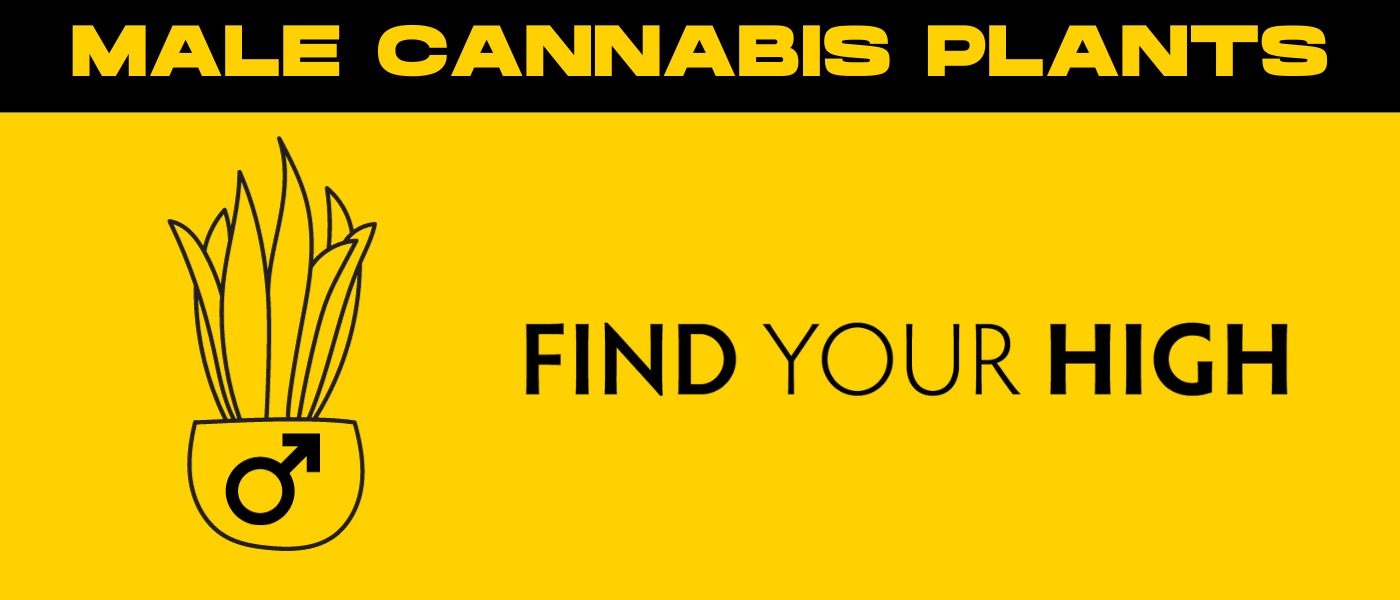Calling all growers, green thumbs, and cannabis enthusiasts! We’re back with another blog, this time diving into the topic of the male cannabis plant – oh yes, you read right!
As it turns out, the future is female… including in the world of cannabis flowers and cultivation. While they may not be the stars of the show when it comes to producing those beloved, resin-laden buds, these gents of the garden play a crucial role in the cannabis ecosystem. You might be thinking, “But, why should I care about male cannabis plants?”
Well, buckle up, because this blog is about to take you on a journey of discovery that will not only brush up on the importance of these unsung heroes but also might just flip your entire understanding of cannabis cultivation on its head! Let’s begin.
Male Cannabis Plant Characteristics
The male cannabis plant, often overshadowed by its more active female counterpart, has loads of fascinating and unique characteristics that are totally worth exploring.
Even though the male plant might not get as much attention as the female cannabis plant, understanding these traits is valuable for growers, botanists, and the cannabis industry as a whole.
By diving into the hidden intricacies of the male cannabis plant, we can uncover a whole new world of possibilities and applications within this botanical wonderland.
Physical Appearance
Male cannabis plants have some seriously interesting physical traits that make them stand out from the ladies. For example, they tend to grow taller and look more skinny, reaching for the sky to soak up that sweet, sweet sunlight. It’s like they have a survival strategy to dominate the scene and spread their pollen. Similar to the human male population? We’ll let you be the judge.
Anyways, if you take a closer look, you’ll spot these little balls on short stalks, otherwise known as the pre-flowers of male plants. Note that these structures are totally different from the hair-like pistils you see on female plants.
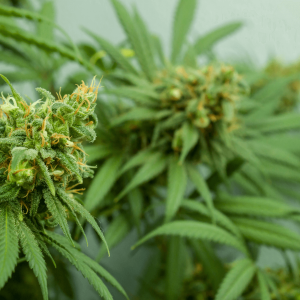
These differences are super important for cannabis growers because they determine the plant’s purpose and how well it produces. Male plants are essential for breeding new strains, while females are known for their high cannabinoid concentration. So, being able to tell the difference between male pot plants and female cannabis plants based on their looks is a game-changer for the success of your greenhouse.H3: Growth Patterns
In terms of growth patterns, male cannabis plants usually mature faster than females. They tend to display signs of sexual maturity first, such as the development of pollen sacs, even before the female plants have fully entered their flowering stage.
Differences from Female Plants
The ability to distinguish male pot plants from female cannabis plants is crucial for anyone involved in cultivating this versatile plant.
The most prominent difference lies in their reproductive structures. As it turns out, basic male and female biology doesn’t differ too much across species – even that of humans and plants. For example, male cannabis plants are the pollen producers; they generate small, globe-shaped flowers that, once sexually mature, open up to release pollen into the environment.
This pollen, carried by the wind or other natural vectors, is destined to fertilize the flowers of female plants, triggering seed production.
In contrast, female plants have an entirely different role in the propagation cycle. The female cannabis plant is characterized by its long, vase-shaped flowers or ‘pistils.’ These structures are designed to capture the pollen released by male plants.
If left unfertilized, however, female cannabis plants take a remarkable turn. They begin to produce resin-rich flowers, commonly referred to as ‘buds.’
These buds are the most valued part of the cannabis plant, sought after for their high concentration of cannabinoids – the compounds responsible for the plant’s psychoactive properties. And not to mention, these are the beloved buds that end up in your favorite flower jars.
In essence, understanding the differences between male and female cannabis plants is vital. From the pollen-producing male plants essential for seed production to the resin-rich buds of unfertilized female plants, each has a unique role in the life cycle of the cannabis plant and offers different values to cultivators and consumers alike.
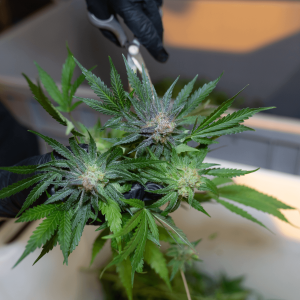
Role of the Male Cannabis Plant
Male cannabis plants are often overlooked due to their lack of psychoactive buds. However, they perform a vital function in the life cycle of the cannabis plant.
Unlike the female cannabis plant, which produces the coveted buds rich in tetrahydrocannabinol (THC), male plants primarily generate pollen. This pollen is crucial for cross-pollination, a process that involves the transfer of pollen from a male weed plant to a female plant.
When a male cannabis plant matures, it develops pollen sacs. These sacs, once fully matured, burst open, releasing a cloud of pollen into the air. Carried by the wind or via insects, this pollen finds its way to the receptive pistils of female plants, triggering the fertilization process.
This is the point where the magic happens: the female plant starts the production of seeds. This is an integral part of the cannabis plant’s survival strategy, as these seeds will eventually fall to the ground, germinate, and grow into new cannabis plants, ensuring the propagation of the species.
But it’s important to give credit where credit is due because the role of male cannabis plants extends beyond simple reproduction.
For breeders, male plants offer the possibility to influence the genetic makeup of the cannabis strains they cultivate. By selectively breeding male plants with certain desirable traits—such as resistance to disease, rapid growth, or hardiness—breeders can enhance these properties in future generations of cannabis plants.
Thus, even though they may not produce the prized female buds, male cannabis plants are far from useless. They are the unsung heroes of the cannabis world, playing an indispensable role in the survival, diversity, and quality of cannabis strains.
Hemp Cultivation
Male cannabis plants have a significant role in hemp cultivation as well.
Hemp, which is grown for its fiber and seeds, is typically produced from dioecious cannabis varieties where male and female flowers grow on separate plants.
In this context, male plants are vital for ensuring a healthy and robust hemp crop, and their pollen is needed for the production of viable hemp seeds.
Identifying Male Cannabis Plants
Recognizing the sex of cannabis plants is a pivotal step toward orchestrating a successful grow operation. Though novice growers may initially struggle to discern the differences, a keen eye and a bit of knowledge can greatly streamline this task.
The male cannabis plants, much like their female counterparts, have distinct characteristics that set them apart. One of the earliest signs of a male plant is the formation of small pollen sacs. These sacs commonly appear at the intersection of the male weed plant’s branches and the stem.
The male pollen sacs are typically round in shape and exhibit a spiky texture, a stark contrast to the teardrop-shaped and smoother calyxes of female plants.
These differences, though subtle, are stark once growers know what to look for. Differentiating male plants from females early on in the growth process is not a trivial task. It’s a crucial step because male plants, if left undetected, can considerably diminish the potency of female plants.
How so? Glad you asked.
Males can diminish the potency of female plants by pollinating the females, leading to a batch of seeds rather than the desired resin-rich flowers. This can drastically affect the quality of the harvest, turning what could have been a crop abundant with dense, trichome-rich flowers into a collection of seeded buds.
Prompt identification and separation of male plants ensure a bountiful harvest of high-quality, seedless buds referred to as “sinsemilla”. This term, stemming from the Spanish words “sin” (without) and “semilla” (seed), denotes the highest grade of cannabis, and achieving this requires growers to maintain meticulous attention to detail throughout the cultivation process.

Male Cannabis Plant Uses
Male cannabis plants, often underestimated compared to their female counterparts, actually have numerous uses and applications. Let’s dig deeper into the potential benefits and practicalities of these underappreciated male marijuana plants first.
- Hemp Fiber Production: The male cannabis plant serves as a valuable resource for hemp fiber production. This is because the fibers found on the main stem of male plants are generally longer and stronger than their female counterparts, making them perfect for creating a variety of industrial products ranging from textiles to paper.
- Breeding and Genetics: Male cannabis plants play a crucial role in breeding and genetic modification. Breeders often select males with desirable traits to pollinate female plants, producing seeds with enhanced features, such as improved resistance to disease, higher yield, or specific cannabinoid and terpene profiles.
- Hemp Seeds and Nutritional Value: The seeds provided by male cannabis plants are a rich source of nutrients. They are packed with protein, healthy fats, and a variety of minerals, making them a nutritious addition to any diet.
Male vs. Female Plants
When discussing the cultivation of cannabis plants, understanding the difference between male and female plants is not just beneficial, but essential to the process.
Female plants are often the stars of the show, highly sought-after by cultivators for their ability to produce larger, more potent buds that are rich in THC, CBD, and other desirable cannabinoids. These are the plants that, under optimal conditions, will provide the smokable product that consumers are familiar with.
However, this doesn’t mean that male plants should be entirely discounted. While they may lack the smokable buds that female cannabis plants produce, male plants play a pivotal role in the breeding process. They are pollen producers, contributing the necessary components for seed production.
Without the participation of male plants, new generations of cannabis plants would be impossible.
An understanding of this delicate balance between the genders is a crucial part of a successful cultivation process.
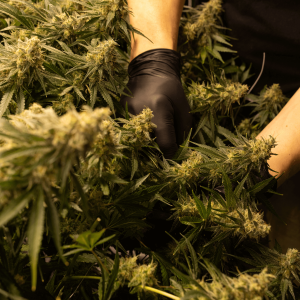
Comparative Advantages
While female cannabis plants are often preferred for their potent buds used in smoking and medicinal applications, we can’t overlook their male counterparts!
The distinct advantage of female plants lies in their ability to produce THC-rich buds, which are harvested, dried, and used for their psychoactive effects; however, the importance of male plants in a breeding program is equally crucial.
The male plants play a pivotal role in breeding programs promoting genetic diversity, a crucial aspect of any successful cultivation operation. The cannabis plants produce pollen, which can fertilize the female plant’s flowers, leading to the production of seeds. These seeds carry the genetic information from both parent plants, allowing breeders to create completely new and unique cannabis strains.
The ability to craft new strains not only adds variety to the market but also allows for the development of strains with specific characteristics, such as improved resistance to diseases, tailored cannabinoid profiles, or enhanced yield.
Therefore, the roles and advantages of both male and female plants are clear and demonstrate the intricate balance and interplay in a successful growing operation. Their respective contributions are what make a diverse, robust, and innovative cannabis industry possible.
Managing Male Plants in a Grow Operation
The management of male plants in any grow operation is essential to prevent unwanted pollination.
Uncontrolled, a single male can pollinate an entire crop, resulting in seedy buds and fewer leaves. Therefore, identifying and separating male plants early can help maintain the quality of the yield.
Importance of Maintaining a Balanced Ratio
Keeping a good balance between the male plant and female plants is super important in a breeding program.
First of all, it underpins the foundation for genetic diversity, an essential factor in the evolution and survival of species. Genetic diversity shields plant populations from the harmful effects of diseases and pests, and facilitates adaptation to changing environmental conditions. In other words, genetic diversity plays a huge role in disease resistance among cannabis plants.
This balance also opens up opportunities for strain creation, allowing cultivators to enhance specific desirable traits in other crops, thereby leading to improved plant varieties.
Additionally, a healthy gender ratio contributes to the overall well-being of the crop.
In contrast, an imbalanced ratio can cause a myriad of challenges. Over-pollination, for instance, can result in excessive seed production at the expense of the plant’s other functions, while an abundance of male plants can lead to inbreeding, weakening the genetic vitality of the crop over time.
That being said, grasping and handling the gender ratio isn’t just a part, but a key element of successful cannabis cultivation. It requires thoughtful planning, monitoring, and intervention to guarantee the sustainable and fruitful growth of the cannabis crop.
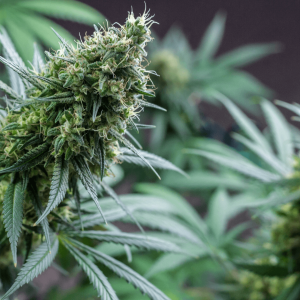
Conclusion
In conclusion, the male cannabis plant plays a significant role in the cannabis industry, often overlooked but crucial in its ability to contribute to the genetic diversity of the crop. These male weed plants aren’t just extras, they play a crucial role in developing new and improved cannabis strains.
The future of the male cannabis plant in the industry is promising, with potential breakthroughs in understanding their contribution to the crop’s resilience, potency, and overall quality. The industry anticipates advancements in the utilization of the male cannabis plant, potentially resulting in greater sustainability and efficiency in cannabis production.
Ultimately, the role of the male cannabis plant in the cannabis industry is far from insignificant. Understanding and appreciating their contributions can lead to a more diverse, resilient, and efficient industry. As the cannabis industry continues to mature and innovate, the male cannabis plant’s role will inevitably become more defined and respected.
Frequently Asked Questions
1. When can you tell if a cannabis plant is male?
Identifying the sex of a cannabis plant is a critical step in the cultivation process, with the determination typically becoming discernible about 4-6 weeks into the growth cycle. This period marks the time when the plant enters its flowering stage, a pivotal phase in its growth pattern. At this point in the flowering process, the plant’s gender-specific characteristics begin to manifest.
Male cannabis plants, for instance, will start to develop pollen sacs. These pollen sacs are small, round structures that dangle from the nodes where the leaf and the stem intersect. If you were to visualize them, they would bear a striking resemblance to miniature clusters of grapes. This unique feature distinguishes male cannabis plants from their female counterparts.
On the other hand, female cannabis plants will start to produce structures known as calyxes during the flowering stage. These calyxes, which are teardrop-shaped, will have hair-like structures, identified as pistils, protruding from them. The pistils serve as a solid gender identifier and set female flowers apart from the males.
The ability to differentiate between these gender-specific attributes is of the greatest importance to cultivators. The reason behind this is that the female plants, when left unpollinated, are known to produce the most potent flowers.
These flowers, or buds, are harvested for their rich concentration of cannabinoids, the compounds responsible for the therapeutic and psychoactive effects of cannabis. Therefore, for many growers aiming for high-quality yields, understanding these distinctions can be the key to successful cultivation.
2. Can a male cannabis plant produce flower?
Yes, male cannabis plants do indeed produce flowers. However, these male flowers are fundamentally different from those seen on their female counterparts.
The reason behind this lies in the differing biological roles of the male marijuana plant and female plants in the reproductive process. Male cannabis plants carry out their part of reproduction by producing small, pollen-filled sacs in their flowers. These sacs, once matured, open up to release their pollen into the surrounding environment. The pollen then travels primarily via wind to reach the female cannabis plants.
On the other hand, female cannabis plants do not produce pollen. Instead, their flowers are designed to catch the pollen that the males distribute.
Once a pollen grain lands on female flowers, it triggers the development of cannabis seeds within the female plant. And it is within these very female flowers or ‘buds’ that cannabinoids, the chemicals responsible for many of the medicinal and recreational effects of cannabis, are produced in the highest concentrations.
Consequently, while male cannabis plants do produce flowers, they are not the prized, cannabinoid-rich buds proliferated by female plants. Their role is a crucial one in the wild, contributing to the continuation of the cannabis species through natural reproduction.
However, for those cultivating cannabis for medicinal or recreational use, these male cannabis flowers are often seen as less desirable due to their lack of cannabinoids.

 Rewards
Rewards




